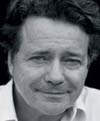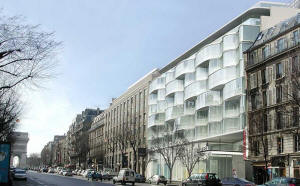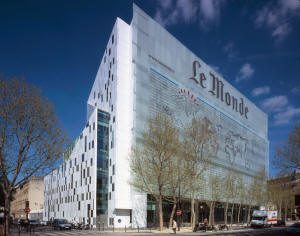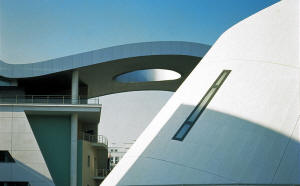 |
New York Architecture Images-New York Architects Atelier Christian de Portzamparc |
 2003-2008 Hotel Renaissance Wagram in Paris  2001-2004 Headquarters for the press group Le Monde in Paris  1984-1995 The City of Music in Paris |
|
|
During New York's starchitect boom in the middle of the decade, he had a
design at 400 Park Avenue South, but it never materialized. (The lot is
now being developed by Toll Brothers and Equity Residential.) Instead,
he was active in Europe, designing the Philharmonie Luxembourg, a
concert hall with strands of circular rods forming an arrangement akin
to harp strings, as well as the headquarters for the newspaper Le Monde. And while the city has a reputation for being difficult -- land use attorneys are often said to be as important as architects -- de Porzamparc finds it refreshing. In fact, New York is very attractive, he said. There are fewer constraints than in most of our European cities. De Portzamparc was born in Casablanca in 1944, studying the École des Beaux-Arts in Paris. He has a background in both architecture and urban planning, and said he admires Rem Koolhaas, Frank Gehry, Seijima, Herzog & de Meuron. With that background, de Portzamparc seems an ideal fit for cosmoplitan New York. Incidentally, One57's initial customers are said to be predominantly wealthy foreigners, who appear to find the location and its views among the finest in the world. And perhaps reflecting its worldliness, in November, Extell closed on a $700 million construction loan from syndicate that included Bank of America, Spain's Banco Santander S.A., Abu Dhabi International Bank, Capital One and the Bank of Nova Scotia. But beyond the economics of architecture, de Portzamparc stresses practicality as a path to good design. We need to rediscover the essence of the meaning of 'the use,' he said. Architecture is above all here for a better living. Every gesture, every shape must be justified by various reasons that would reinforce their reason to be, their use, and will give more sense to their beauty. A rendering of One57 and the Central Park skyline, viewed from the north. (Atelier Christian de Porzemparc) During New York's starchitect boom in the middle of the decade, he had a design at 400 Park Avenue South, but it never materialized. (The lot is now being developed by Toll Brothers and Equity Residential.) Instead, he was active in Europe, designing the Philharmonie Luxembourg, a concert hall with strands of circular rods forming an arrangement akin to harp strings, as well as the headquarters for the newspaper Le Monde. And while the city has a reputation for being difficult -- land use attorneys are often said to be as important as architects -- de Porzamparc finds it refreshing. In fact, New York is very attractive, he said. There are fewer constraints than in most of our European cities. De Portzamparc was born in Casablanca in 1944, studying the École des Beaux-Arts in Paris. He has a background in both architecture and urban planning, and said he admires Rem Koolhaas, Frank Gehry, Seijima, Herzog & de Meuron. With that background, de Portzamparc seems an ideal fit for cosmoplitan New York. Incidentally, One57's initial customers are said to be predominantly wealthy foreigners, who appear to find the location and its views among the finest in the world. And perhaps reflecting its worldliness, in November, Extell closed on a $700 million construction loan from syndicate that included Bank of America, Spain's Banco Santander S.A., Abu Dhabi International Bank, Capital One and the Bank of Nova Scotia. But beyond the economics of architecture, de Portzamparc stresses practicality as a path to good design. We need to rediscover the essence of the meaning of 'the use,' he said. Architecture is above all here for a better living. Every gesture, every shape must be justified by various reasons that would reinforce their reason to be, their use, and will give more sense to their beauty. |
|
|
links |
|